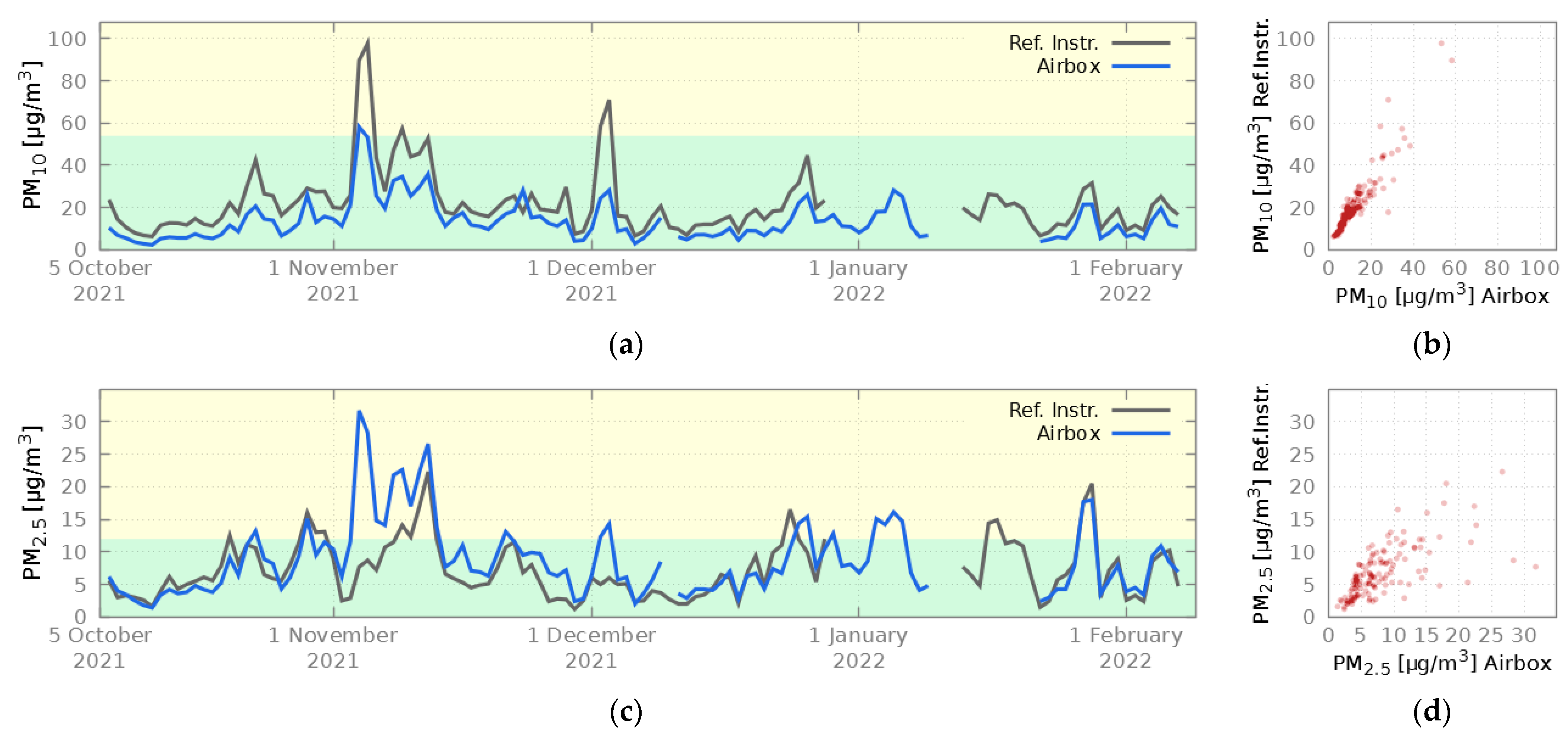Field Performance Evaluation of Air Quality Low-Cost Sensors Deployed in a Near-City Space-Airport †
Abstract
:1. Introduction
2. Materials and Methods
2.1. Airbox, the Low-Cost Sensor System, and Its On-Field Positioning
2.2. Reference Instrumentation and Open Data from Air-Quality Regulatory Monitoring Network
2.3. Comparison of the Measured Data and Procedure for Correcting Gas Concentrations
- Mean of the daily average values of the Airbox corrected measurements and mean of the daily averages of the ARPA stations;
- Difference between the maximum and minimum values of the daily averages of the Airbox corrected measurements and the difference between the maximum and minimum values of the daily averages of the ARPA stations.
- O3 concentration values;
- NO2 concentration values from which the corrected O3 concentration values have been subtracted to evaluate an O3 cross-sensitivity contribution.
3. Results
4. Summary and Conclusions
Author Contributions
Funding
Institutional Review Board Statement
Informed Consent Statement
Data Availability Statement
Acknowledgments
Conflicts of Interest
References
- Borrego, C.; Costa, A.M.; Ginja, J.; Amorim, M.; Coutinho, M.; Karatzas, K.; Sioumis, T.; Katsifarakis, N.; Konstantinidis, K.; De Vito, S.; et al. Assessment of air quality microsensors versus reference methods: The EuNetAir joint exercise. Atmos. Environ. 2016, 147, 246–263. [Google Scholar] [CrossRef]
- EuNetAir. Available online: http://www.cost.eunetair.it/ (accessed on 11 August 2023).
- Penza, M.; Suriano, D.; Pfister, V.; Prato, M.; Cassano, G. Urban air quality monitoring with networked low-cost sensor-systems. Proceedings 2017, 1, 573. [Google Scholar] [CrossRef]
- Penza, M.; Suriano, D.; Pfister, V.; Prato, M.; Cassano, G. Wireless Sensors Network Monitoring of Saharan Dust Events in Bari, Italy. Proceedings 2018, 2, 898. [Google Scholar] [CrossRef]
- EU. Directive 2008/50/EC of the European Parliament and of the Council of 21 May 2008 on Ambient Air Quality and Cleaner Air for Europe; European Commission: Brussels, Belgium, 2008; Available online: https://eur-lex.europa.eu/eli/dir/2008/50/oj (accessed on 11 August 2023).
- Mead, M.; Popoola, O.; Stewart, G.; Landshoff, P.; Calleja, M.; Hayes, M.; Baldovi, J.; McLeod, M.; Hodgson, T.; Dicks, J.; et al. The use of electrochemical sensors for monitoring urban air quality in low-cost, high-density networks. Atmos. Environ. 2013, 70, 186–203. [Google Scholar] [CrossRef]
- Spinelle, L.; Gerboles, M.; Aleixandre, M. Performance Evaluation of Amperometric Sensors for the Monitoring of O3 and NO2 in Ambient Air at ppb Level. Procedia Eng. 2015, 120, 480–483. [Google Scholar] [CrossRef]
- ARPA Puglia, Apulia Regional Environmental Protection Agency (In Italian). Available online: https://www.arpa.puglia.it/ (accessed on 11 August 2023).
- United States Environmental Protection Agency. EPA-454/B-18-007—Technical Assistance Document for the Reporting of Daily Air Quality—The Air Quality Index (AQI); United States EPA-Environmental Protection Agency Office of Air Quality Planning and Standards: Research Triangle Park, NC, USA, 2018. [Google Scholar]



| Station | Line-of-Sight Distance [km] | Azimuth * [°] | Type | Pollutants of Interest in This Work ** | |||
|---|---|---|---|---|---|---|---|
| PM10 | PM2.5 | NO2 | O3 | ||||
| Grottaglie | 3.3 | 38.0 | Urban Background | + | - | + | + |
| Ceglie Messapica | 17.7 | 32.5 | Urban Background | + | + | + | - |
| Francavilla Fontana | 16.0 | 84.0 | Urban Traffic | - | - | + | - |
| Taranto-Talsano | 15.1 | 220.5 | Urban Background | + | - | + | + |
| Taranto-San Vito | 17.9 | 235.5 | Urban Background | + | - | + | + |
| Taranto-Alto Adige | 13.0 | 242.5 | Urban Traffic | + | + | + | - |
| Taranto-Machiavelli | 15.0 | 259.0 | Industrial | + | + | + | - |
| Taranto-Archimede | 14.3 | 261.0 | Industrial | + | + | + | - |
| Taranto-CISI | 12.4 | 273.0 | Industrial | + | + | + | - |
| Statte-Ponte Wind | 19.2 | 274.0 | Industrial | + | - | + | - |
| Statte-Sorgenti | 17.4 | 288.0 | Industrial | + | - | + | - |
| Massafra | 25.5 | 290.0 | Industrial | + | - | + | - |
| Martina Franca | 21.5 | 344.5 | Urban Traffic | + | - | + | - |
| Cisternino | 25.4 | 3.0 | Urban Background | + | - | + | + |
Disclaimer/Publisher’s Note: The statements, opinions and data contained in all publications are solely those of the individual author(s) and contributor(s) and not of MDPI and/or the editor(s). MDPI and/or the editor(s) disclaim responsibility for any injury to people or property resulting from any ideas, methods, instructions or products referred to in the content. |
© 2023 by the authors. Licensee MDPI, Basel, Switzerland. This article is an open access article distributed under the terms and conditions of the Creative Commons Attribution (CC BY) license (https://creativecommons.org/licenses/by/4.0/).
Share and Cite
Pfister, V.; Prato, M.; Penza, M. Field Performance Evaluation of Air Quality Low-Cost Sensors Deployed in a Near-City Space-Airport. Eng. Proc. 2023, 48, 27. https://doi.org/10.3390/CSAC2023-14911
Pfister V, Prato M, Penza M. Field Performance Evaluation of Air Quality Low-Cost Sensors Deployed in a Near-City Space-Airport. Engineering Proceedings. 2023; 48(1):27. https://doi.org/10.3390/CSAC2023-14911
Chicago/Turabian StylePfister, Valerio, Mario Prato, and Michele Penza. 2023. "Field Performance Evaluation of Air Quality Low-Cost Sensors Deployed in a Near-City Space-Airport" Engineering Proceedings 48, no. 1: 27. https://doi.org/10.3390/CSAC2023-14911
APA StylePfister, V., Prato, M., & Penza, M. (2023). Field Performance Evaluation of Air Quality Low-Cost Sensors Deployed in a Near-City Space-Airport. Engineering Proceedings, 48(1), 27. https://doi.org/10.3390/CSAC2023-14911







